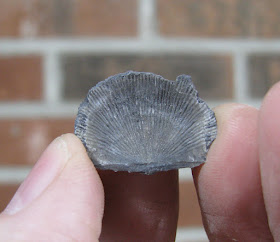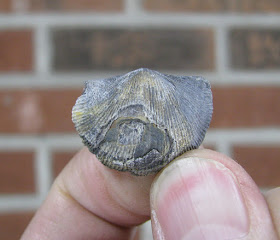Devonochonetes coronatus is a very common fossil in the Moscow formation of New York. It's easy to identify as it is the largest of the Chonetid type brachiopods found in the middle Devonian. The shell is rectangular in outline, the pedicle valve is convex while the brachial valve is concave. A straight hinge line runs the length of the posterior and sometime you will find spines, or the bases of them, along the pedicle valve.
Specimen #1 - Pedicle valve
Anterior
Brachial valve
Posterior
Profile
Hinge line with spine bases
Specimen #2 - Pedicle valve
Anterior
Brachial valve - note the impression of a Protoleptostrophia perplana brachiopod that covers the Brachial valve.
Posterior
Profile
This specimen is interesting due to the damage to the brachial valve. It exposes the interior of the brachial valve, the sediment that filled in where the animal used to live, and the interior of the pedicle valve. The layering is interesting and shows you just how little space the animal had to live in.
Compare this specimen to one from the Silica shale.
These specimens were found at a borrow pit on Deep Springs Road in Madison County, NY which exposes the Windom shale member of
the Moscow formation (middle Devonian in age, Givetian stage.)












No comments:
Post a Comment